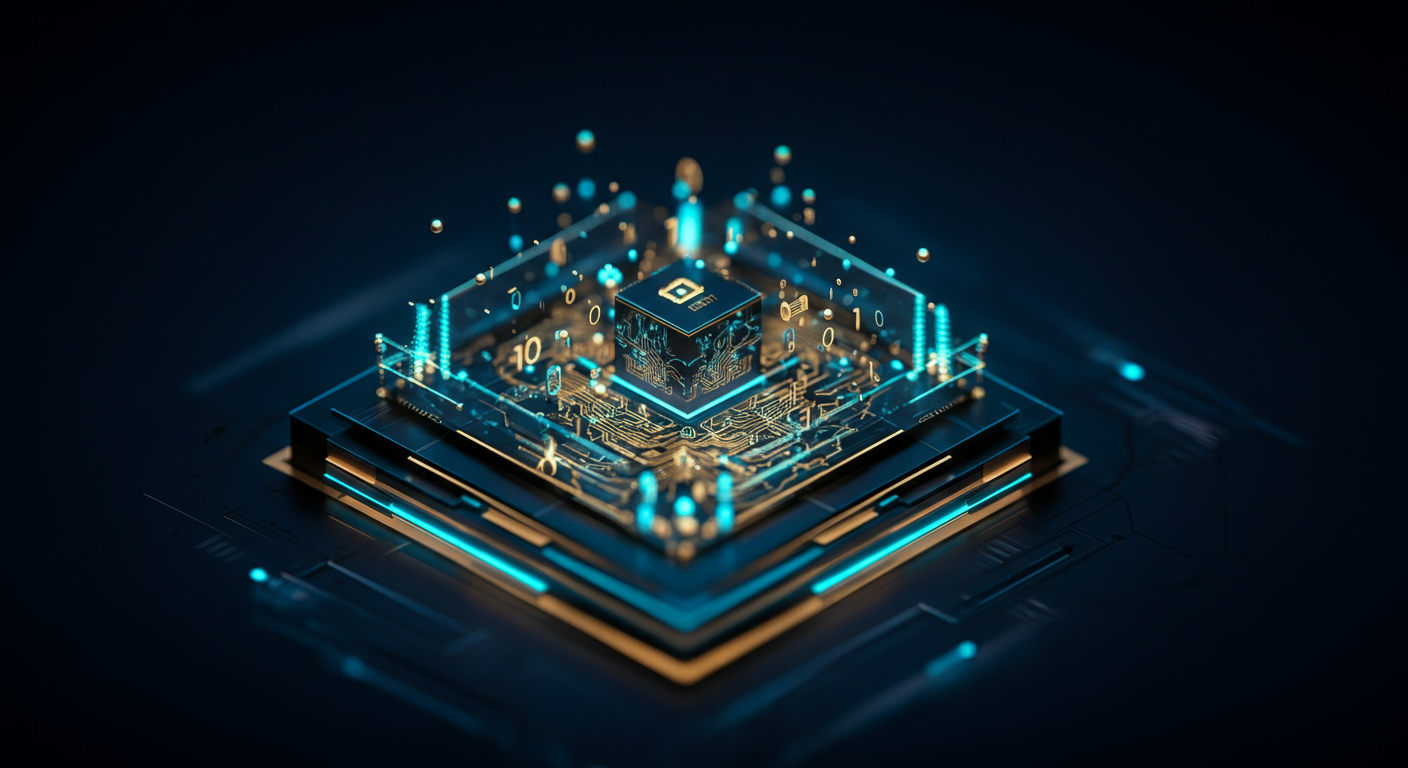GPT-5 and Intel's Next Chapter: Decoding the Future of AI

GPT-5: The Dawn of a New AI Era
The relentless march of progress brings us to the precipice of GPT-5, poised to redefine what's possible with artificial intelligence.
Speculation vs. Reality
"The difference between genius and stupidity is that genius has its limits." - Me, probably, in a few years.
Let's be honest, the internet is buzzing with hype. But let's separate fact from fiction. While concrete details remain under wraps, informed speculation paints a picture of significant advancements, not just incremental improvements. We must distinguish between educated guesses and wishful thinking. For example, understanding existing tools like ChatGPT, a powerful conversational AI, helps ground expectations for its successors.
Beyond Text: Multimodal AI
Imagine an AI that doesn't just understand text, but also interprets images, audio, and video with human-like comprehension. This is the promise of multimodal AI. GPT-5 could potentially analyze a video clip and generate a summary, create music from a text prompt, or even design a building based on a sketch. Tools like image generation AI showcase the potential, but integrating all modalities into a seamless experience is the real challenge.Architectural Leaps
Rumors suggest significant architectural changes under the hood of GPT-5. This could involve a shift towards more efficient transformer models, potentially enabling faster processing speeds and lower energy consumption. Think of it like upgrading from a combustion engine to an electric one – same output, vastly improved efficiency. Such advancements are crucial for deploying AI at scale and making it accessible to more users. For software developers, this means understanding how to leverage tools like Software Developer Tools to build applications that can efficiently utilize these next-generation models.Ethical Considerations

With great power comes great responsibility. As AI models become more sophisticated, addressing GPT-5 ethical concerns like bias mitigation becomes paramount. We need robust GPT-5 bias mitigation strategies and frameworks to ensure fairness, transparency, and accountability. Consider this:
- Bias in training data can lead to skewed outputs.
- Responsible AI development requires diverse datasets and rigorous testing.
- Explainability is crucial for understanding how AI arrives at its decisions. Tools like Learn AI in Practice can help professionals better navigate these complex issues and implement AI responsibly.
GPT-5's arrival heralds not just a new model, but potentially a paradigm shift in how we interact with AI.
GPT-5 vs. GPT-4: A Quantum Leap or Incremental Upgrade?

The burning question: Is GPT-5 a revolutionary overhaul or a refined iteration of its predecessor? Let's dissect the key areas.
Benchmark Comparisons: We can expect improvements across the board – reasoning, problem-solving, and creativity. However, the magnitude* of those gains is what truly matters. Will it be a marginal improvement, or will GPT-5 demonstrate abilities previously thought unattainable? Think of it like transitioning from a horse-drawn carriage to a Model T Ford versus launching a rocket – both offer transportation, but one represents a fundamental shift.
Contextual Understanding: GPT-4 already handles nuanced prompts reasonably well. But GPT-5 aims to transcend simple understanding and achieve genuine contextual awareness*. >Imagine giving ChatGPT a complex brief with interwoven dependencies and implicit expectations; GPT-5 should ideally parse it not just literally, but with an understanding of the underlying goals and motivations. ChatGPT is a versatile language model that can generate human-like text, translate languages, and answer questions. It's a fundamental tool for anyone working with AI-driven text generation.
- Customization and Fine-tuning: Expect greater flexibility in tailoring models to specific needs. The ability to fine-tune Design AI Tools, for instance, to generate uniquely tailored outputs for specific creative briefs is huge.
Resource Requirements: Power comes at a price. GPT-5's advancements will undoubtedly demand significant computational resources. One long-tail consideration is GPT-5 hardware requirements: Will access be limited by hardware constraints? Another key consideration is GPT-5 training data size*: Will the larger model require exponentially larger datasets? Increased energy consumption is another crucial consideration.
The Road Ahead
Ultimately, GPT-5's true impact will be revealed through its performance and accessibility. It could redefine AI, making sophisticated capabilities available to all, or it could be a subtle evolution, pushing the boundaries of what's possible but remaining within reach for only a select few. Either way, the journey is far from over, and the Top 100 AI Tools list is always updating to reflect these changes!
Intel's ambitions to be an AI powerhouse face both opportunities and challenges.
CEO Shuffle: A Pivot Point?
Rumors of leadership changes at Intel raise crucial questions. Could a new CEO accelerate their AI strategy, or will it cause disruption? The decision likely hinges on Intel's capacity to adapt to the rapidly shifting AI landscape. A leadership change might signal a renewed commitment to AI innovation, potentially attracting fresh perspectives and investment, but it could also stall progress if not managed effectively.
AI Strategy: Catching Up
Intel needs a bold AI strategy to rival competitors like NVIDIA and AMD.
“Our current trajectory isn’t sustainable; we need a paradigm shift.” - Anonymous Intel Engineer, 2025
Is their current strategy too conservative? Here’s a breakdown:
- Existing Strengths: Leveraging their CPU expertise and integrating AI acceleration into their chips.
- Challenges: Catching up in the GPU space, which is critical for AI training.
- Opportunities: Exploring novel AI chip architectures and focusing on edge AI applications.
Chip Manufacturing: The Foundation
Intel’s push to regain chip manufacturing dominance via Intel foundry services AI is intertwined with its AI ambitions. Advanced chip fabrication is crucial for efficient and powerful AI processors. Successfully executing their chip roadmap, including producing leading-edge Intel AI chip roadmap designs, can significantly boost their competitive edge and secure the supply chain for their AI initiatives.
The Road Ahead
What future role can Intel carve out in the AI ecosystem? Success depends on:
- Strategic Partnerships: Collaborating with AI software companies.
- Foundry Prowess: Delivering advanced chips for AI applications.
- Innovation: Developing unique AI architectures.
The race towards more sophisticated AI models like GPT-5 is not just a software story; it's a hardware revolution in disguise.
Hardware Optimization: AI's Insatiable Appetite
AI models, especially Large Language Models (LLMs), are gluttons for processing power. This hunger drives innovation in hardware design. For instance, GPT-5, requires exponentially more computational resources than its predecessors. This demand fuels:- Specialized AI chips: Companies are designing chips specifically tailored for AI workloads, like TPUs (Tensor Processing Units), optimizing for matrix multiplication—the core operation in deep learning. Consider Google's AI for Developers, they offer cloud based tools that leverage TPUs to accelerate your AI projects.
- Memory bandwidth improvements: Feeding data to these chips quickly becomes crucial. High Bandwidth Memory (HBM) is emerging as a key technology.
Neuromorphic Computing: Mimicking the Brain
Traditional computers process information sequentially. Neuromorphic computing, however, aims to mimic the human brain's parallel processing capabilities, promising significant efficiency gains. This tech could revolutionize neuromorphic computing for AI:Imagine AI processing information with the energy efficiency of a human brain. That's the promise of neuromorphic chips.
Edge AI: Intelligence at the Source
Transferring data to the cloud for processing introduces latency and raises privacy concerns. Edge AI applications address these issues by bringing AI processing closer to the data source. Think:- Autonomous vehicles: Real-time decision-making is critical.
- Smart cameras: Analyzing video feeds on-site reduces bandwidth usage.
Quantum Computing: The Distant Frontier
While still in its infancy, quantum computing holds immense potential for accelerating AI research. Quantum computers could potentially solve optimization problems intractable for classical computers. Keep in mind the following:- Drug discovery: Simulating molecular interactions to identify promising drug candidates.
- Materials science: Designing new materials with specific properties.
Here's the deal: while GPT-5 sparks excitement, we need to ground our expectations.
Addressing AI's Current Limitations
Current AI models, even the most advanced, aren't infallible. They can perpetuate biases present in their training data, leading to unfair or discriminatory outcomes.
- Example: An AI used in hiring might unintentionally favor certain demographics, based on historical hiring data.
- They also make errors, sometimes confidently presenting false information.
The Indispensable Role of Human Oversight
AI isn't meant to replace humans, but to augment our abilities. Effective AI implementation requires:
- Human-in-the-loop systems: Ensuring a human reviews and validates AI-generated outputs.
- Collaboration: AI should assist, not dictate. This ensures ethical considerations are addressed and biases are mitigated. For instance, ChatGPT, while powerful, still needs human guidance to refine its responses.
Broader Societal Implications of AI
AI's impact stretches far beyond individual productivity, and AI job displacement statistics are real. We must consider the following:
- Job Displacement: Automation could lead to job losses in certain sectors, requiring retraining and adaptation.
- Economic Inequality: AI-driven productivity gains could exacerbate existing income disparities.
- Misinformation: AI-generated content can be used to spread false or misleading information. Combating AI misinformation becomes crucial.
The AI Singularity: Fact vs. Fiction
The "singularity," a hypothetical point where AI surpasses human intelligence and triggers runaway technological growth, is often sensationalized.
- While rapid progress is undeniable, predicting such an event is speculative.
- Focusing on practical applications and ethical considerations is more productive than dwelling on science fiction scenarios. You can learn more with this Guide to AI Fundamentals.
Democratizing AI is no longer a futuristic ideal, but a present-day imperative.
Open Source Initiatives
Open-source AI projects are leveling the playing field. Imagine, access to powerful models without the hefty price tag! Projects like LLaMA and Stable Diffusion are making AI development more accessible. These open source alternatives to GPT-5 let smaller organizations and individual developers innovate without being dependent on Big Tech. For example, check out Hugging Face, a community platform where you can find tons of open-source AI models.
"Open-source is not just about code; it's about collaboration and shared progress."
Cloud-Based AI Platforms
Cloud platforms like Google Cloud AI Platform and Azure Machine Learning provide on-demand access to computing resources and pre-trained models. This simplifies deployment, but it also raises questions about data privacy and vendor lock-in. One should carefully evaluate terms, ensuring the cloud does not turn into a gilded cage.
AI for Everyone
Promoting AI literacy programs for adults is critical. We need more than just coders; we need informed citizens who can understand AI's implications. This means making education accessible, offering resources like the AI Explorer to help those new to AI understand it's fundamental workings. Initiatives that demystify AI empower individuals and organizations to leverage it effectively. Think of it as the 21st-century equivalent of learning to read.
The Future of AI Education
Traditional education is playing catch-up. The curriculum needs to evolve to include AI ethics, prompt engineering, and critical thinking about AI outputs. Platforms like DataCamp are stepping up, but universities must adapt as well. The goal? To equip individuals with the skills to not just use AI, but to shape it responsibly.
- Upskilling initiatives are now more critical than ever.
- Emphasis on ethics is paramount.
- Lifelong learning becomes the norm, not the exception.
Keywords
GPT-5 release date, GPT-5 features, GPT-5 capabilities, GPT-5 vs GPT-4, Intel CEO Pat Gelsinger, Intel CEO replacement, Intel leadership changes, AI model performance, Future of AI, Generative AI, Large language models, AI ethics, AI safety
Hashtags
#GPT5 #AIRevolution #IntelNews #TechLeadership #FutureofAI
Recommended AI tools
ChatGPT
Conversational AI
AI research, productivity, and conversation—smarter thinking, deeper insights.
Sora
Video Generation
Create stunning, realistic videos and audio from text, images, or video—remix and collaborate with Sora, OpenAI’s advanced generative video app.
Google Gemini
Conversational AI
Your everyday Google AI assistant for creativity, research, and productivity
Perplexity
Search & Discovery
Clear answers from reliable sources, powered by AI.
DeepSeek
Conversational AI
Efficient open-weight AI models for advanced reasoning and research
Freepik AI Image Generator
Image Generation
Generate on-brand AI images from text, sketches, or photos—fast, realistic, and ready for commercial use.
About the Author

Written by
Dr. William Bobos
Dr. William Bobos (known as 'Dr. Bob') is a long-time AI expert focused on practical evaluations of AI tools and frameworks. He frequently tests new releases, reads academic papers, and tracks industry news to translate breakthroughs into real-world use. At Best AI Tools, he curates clear, actionable insights for builders, researchers, and decision-makers.
More from Dr.

